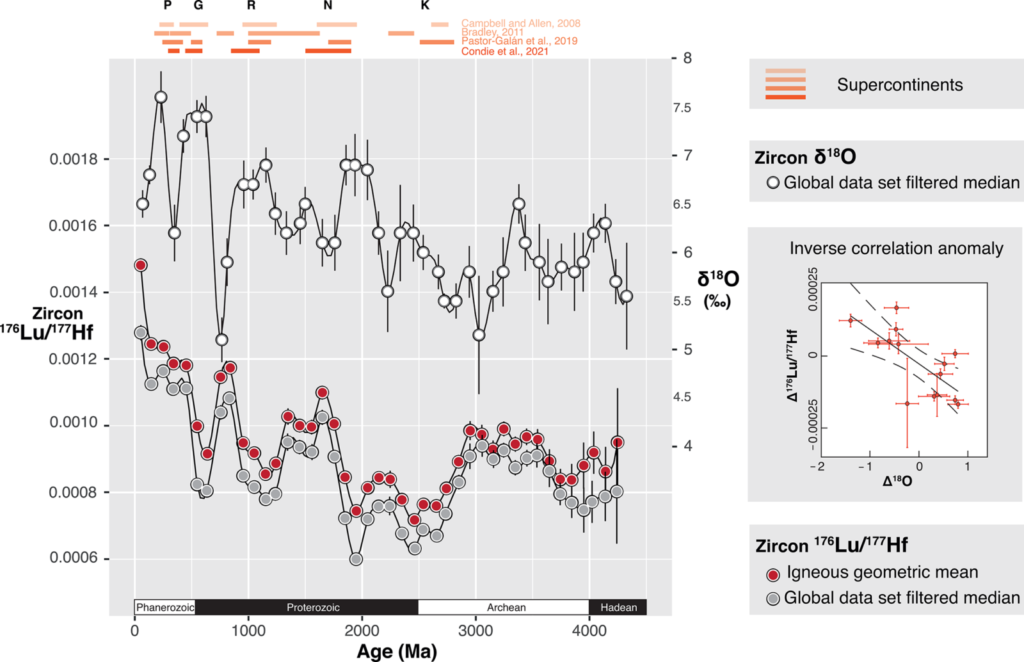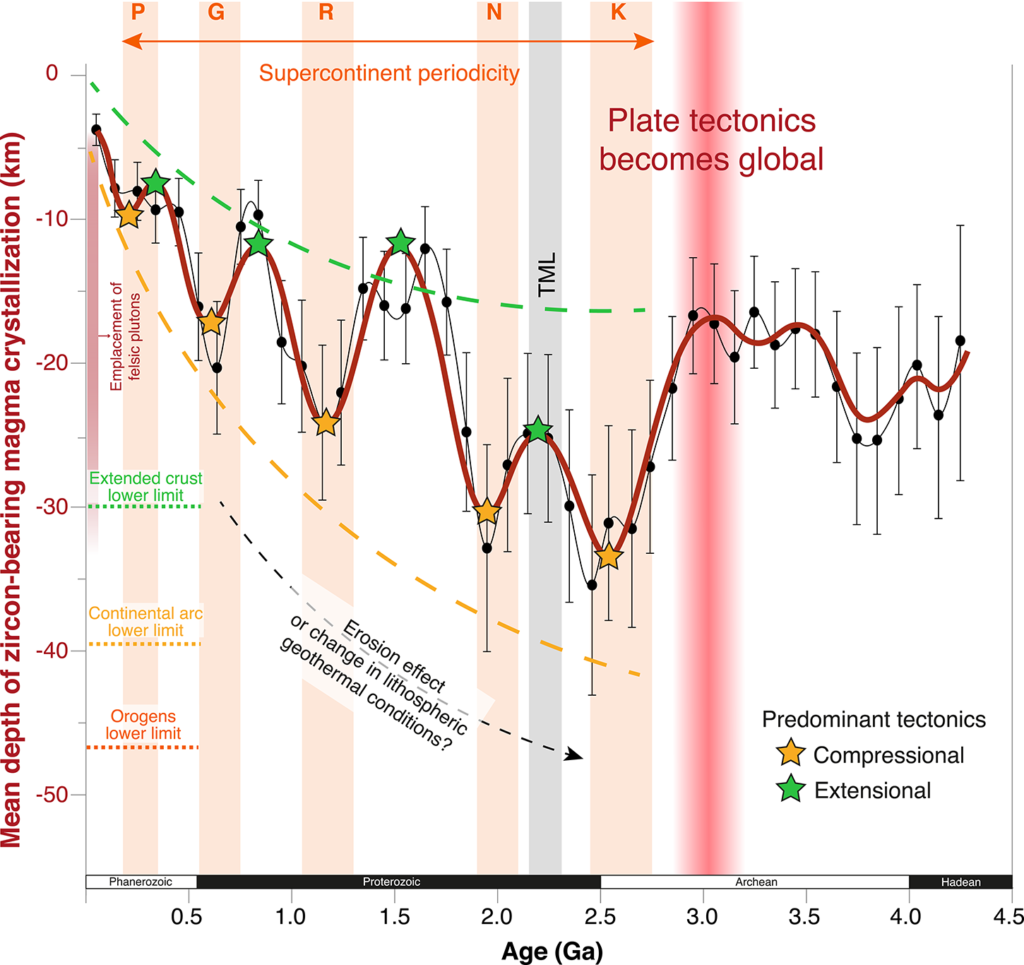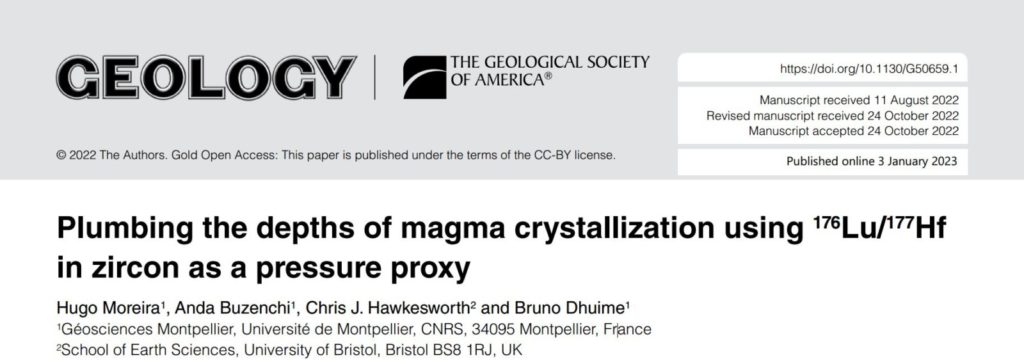
Do you know when you stumble upon a very interesting paper, with a captivating title and you wish you could talk to the author(s)? Well, I did just that. It happens that I know the first author quite well, so I had no shame in contacting him and ask about it. One of his latest papers was published in Geology with the title “Plumbing the depths of magma crystallization using 176Lu/177Hf in zircon as a pressure proxy”. The article is OA, so easily accessible.
In this article, this research group led by Bruno Dhuime* (Université de Montpellier, France) propose a new proxy to determine magma’s crystallisation depths using zircon. The authors go on to apply their newly developed proxy to assess the secular record of magma’s crystallisation depths, linking it to changes in the geodynamic regime. I was very curious and interested by this work, so I asked Hugo, the first author, a few questions regarding their excellent paper:
1. Tell us, briefly, what did you and your co-authors do in this very interesting paper.
We have identified systematic secular variations in the 176Lu/ 177Hf ratios** measured in zircon that inversely correlate with δ18O values from independent datasets. We then developed a geochemical proxy that is pressure dependent and explains the 176Lu/ 177Hf oscillations with respect to the assembly and breakup of the supercontinents.
2. Can you tell us what was the main motivation to develop this proxy?
The main motivation to develop this proxy was to explain why the 176 Lu/ 177 Hf ratios cyclically oscillate with time. It turns out that garnet at the source and zircon fractionation during magma ascent are geological processes that can explain these variations.
3. Why zircon and what does the 176Lu/ 177Hf in zircon tells?
We wouldn’t know the geological history of Earth without the mineral zircon. As continents are generated and destroyed by the relentless activity of plate tectonics, zircon crystals survive and become the record of the continents that once existed and were eroded away. The funny thing is that if isotope geochemists did not need to measure 176Lu/ 177Hf in zircon, they probably wouldn’t know it. However, to obtain precise measurements of the initial 176Hf/ 177Hf in zircon, one must correct for 176Lu isobaric interference on 176Hf and the radiogenic ingrowth from its decay. For many years, this ratio has been measured in zircon but the broader significance of 176Lu/ 177Hf in zircon has been simply neglected. It is not difficult to find papers that contain large compilations of zircon Hf-data where the 176Lu/ 177Hf ratios are simply not reported. It was exciting to discover these variations because people have been doing Lu-Hf analyses in zircons for over 30 years and nobody noticed how meaningful and useful this ratio is. The 176Lu/ 177Hf in zircon seems to be intrinsically related to the nature of the zircon (whether metamorphic or igneous) and with the minerals that co-crystallised with zircon.
4. Tell us a bit more in detail how did you use δ18O with the 176Lu/ 177Hf in zircon.
Once we have established that 176Lu/ 177Hf was intrinsically related to geological processes within the crust and that those in turn were linked to pressures of crystallisation, it became clear that the next step was to verify the variations with the zircon’s oxygen isotope composition. This is because heavier oxygen signature in zircon reflects the involvement of supracrustal materials during magma generation. The involvement of supracrustal rocks is magnified in collisional orogens. It is also the case that the depth inventory in collisional orogens grows as the continental crust becomes thicker. Therefore, there should be an inverse relationship between low 176Lu/ 177Hf in zircon and δ18O. The δ18O increases because of input of supracrustal material and the 176Lu/ 177Hf decreases because more zircons crystallise at depths of the crust where garnet is stable.
5. From the global dataset that you have used and filtered, when do you see that magma crystallises at deeper levels, with the involvement of supracrustal components?
The dataset starts deepening at 3.0 Ga and reaches the lowest 176 Lu/ 177 Hf values at 2.5 and 2.0 Ga. At the same time, we can see that δ18O increases during these intervals.

Figure 1 of Moreira et al. (2023) in Geology illustrating the secular variations of 176Lu/177Hf and δ18O isotopes in zircons. For the full version and to check the discussion behind this figure, go here.
6. When you interpret these as the operation of plate tectonics since 3.0Ga, is it modern-like plate tectonics? Could we explain deeper magma crystallisation involving supracrustal components with any other plausible mechanism?
It really depends on how modern-plate tectonics is defined. If we envisage a mosaic of interlinked, rigid lithospheric plates that rearrange themselves across weak boundaries in a cyclical matter – then yes, we’re definitely looking at a modern plate tectonics regime. Subduction and recycling could be playing a role and also explain the deep magma crystallisation and involvement of supracrustal components. In contrast, we would be looking at something happening from a lower portion of the crust above the mantle wedge, not within the crust.
7. In your figure 4, you show the intercalation of periods where you have average deeper magma crystallisation with periods of average shallower crystallisation depths. How do you explain the trend of decreasing mean magma crystallisation depths with decreasing age?
There are two possible explanations for this trend. The first is that it represents primary magmatic signatures and the depths of crystallisation are getting shallower with time. The second, is that we are looking at an erosional effect whereby older orogens have repeatedly been partially reworked and subjected to more cumulative erosion, which in turn destroys a larger fraction of older zircons and removes them preferentially from the detrital record, resulting in the mean depth of crystallisation being deeper for older orogens. Ultimately, it could be a combination of both factors. That’s a great question and it is actually what I am trying to untangle at the moment with new approaches.

Figure 4 of Moreira et al. (2023) published in Geology illustrating the secular variation in the mean depth of zircon-bearing magmas. You can see the full details and discussion of this figure here.
8. If you could have had other resources at your disposal, what would be an analysis that you would have liked including in this work?
I would have done it experimentally, by growing zircon at controlled pressures with and without the presence of minerals that also incorporate Lu such as garnet. I think that would have helped understanding why some igneous rocks have tightly constrained ages and Hf ratios but large variance of 176Lu/ 177Hf ratios (some up to 25%!).
I would like to thank Hugo for his kindness in answering my questions and for having agreed to give us this overview of their paper. I hope that more people will be eager to read the full version of this article.
Let us know if you liked this blog post and would like to read more paper focus posts.
*This research is part of an European Research Council project awarded to Bruno Dhuime, funded by the Horizon 2020 research and innovation program (no. 817934).
**disclamer: text formatting in our blog does now allow to put 176 in Lu or any other isotope mentioned in the text in superscript.

